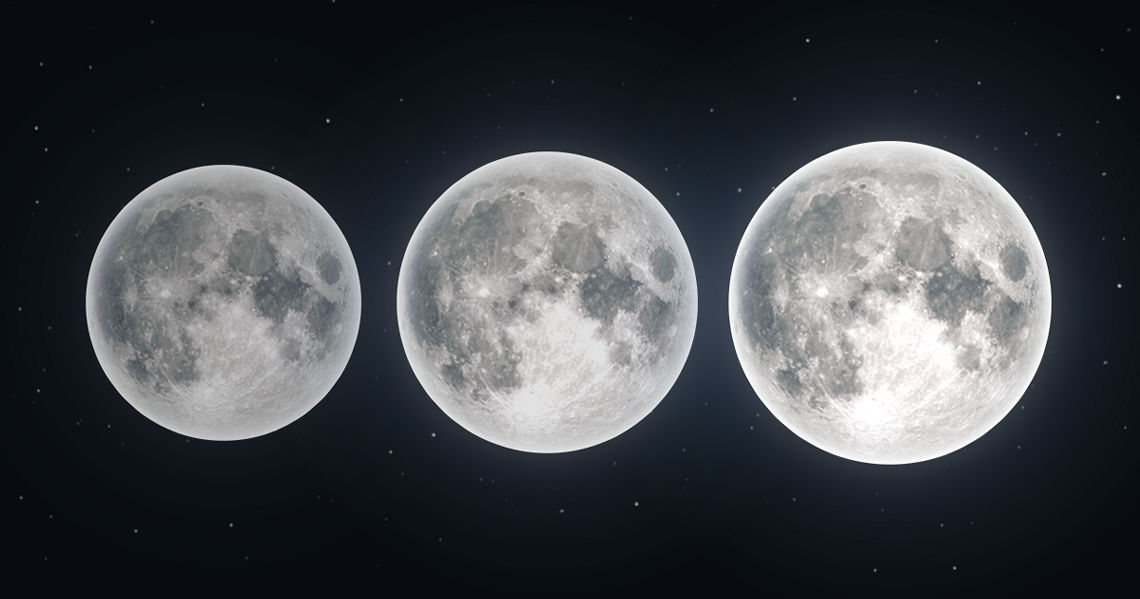Supermoon 2025: Why Is The Moon So Big Tonight?
Have you ever looked up and thought, “Wow, the Moon looks huge”? You might be witnessing a Supermoon — a Full Moon that appears bigger and brighter than usual. But why do Supermoons occur? You'll find the answer in this article. You can also find out when to see the next Full Moon using the Sky Tonight app.
Contents
- Why does the Moon look so big tonight?
- What is a Supermoon?
- How do we know when the next Supermoon is?
- Does the Moon look bigger during a Supermoon?
- How to watch a Supermoon?
- F.A.Q.
- What is a Supermoon: bottom line
Why does the Moon look so big tonight?
There can be two reasons why the Moon appears bigger in the sky:
- The Full Moon is at or near the closest point in its orbit around the Earth – the event called “Supermoon”;
- The Moon is close to the horizon – the so-called “Moon illusion” caused by the trick of our brains that makes the Moon seem larger when it’s low in the sky.
The Moon illusion works with every Full Moon, so if you want to witness it, observe a lunar disk in its full phase at the moonrise or just before dawn. To find out when the next Full Moon is, check the Sky Tonight calendar by tapping the calendar icon at the bottom of the screen and switching to the "Moon" tab. There, you’ll see lunar phases, along with the times of moonrise and moonset for every day of the selected month. Also, find the Moon image in the Info section below the calendar grid and drag it left and right to see how the Moon's angular size in the sky changes from day to day.
In this article, we’ll take a closer look at Supermoons. You can also expand your knowledge by checking out our detailed guide on the Moon illusion.
What is a Supermoon?
A Supermoon is not an official astronomical term. It was coined by the American astrologer Richard Nolle in a 1979 article for Dell Horoscope magazine. Richard Nolle gave such a definition of a Supermoon: “A New or Full Moon which occurs with the Moon at or near (within 90% of) its closest approach to Earth in a given orbit.” And it wasn’t until 2011 that the word started to appear even in popular science articles. Now the definition is acknowledged even by NASA, but it’s still open to different interpretations.
The scientific name for a Supermoon is a “perigee-syzygy of the Earth-Moon-Sun system.” Sounds less exciting, right? But makes more sense:
- Perigee is the closest point the Moon reaches in a complete revolution around the Earth. The Moon’s farthest point from the Earth is called apogee. Perigees and apogees exist because the Moon’s orbit around the Earth is not a perfect circle but an ellipse (oval). The average perigee distance is 363,300 km from the Earth, and the apogee is 405,500 km.
- Syzygy, in astronomy, is the alignment of three or more celestial bodies, mainly referred to the Earth, the Sun, and the Moon or a planet. Syzygy of the Earth-Moon-Sun system leads to the full and new phases of the Moon.
But let’s try to clarify Nolle’s definition of a Supermoon since it is most commonly used.
How do we know when the next Supermoon is?
There is a flaw in Richard Nolle’s definition – he didn’t specify what was “a given orbit.” We may suppose he meant a year’s orbit because it gives us comparatively few Supermoons, and his list is quite short. According to the Nolle’s table of Supermoons, in 2025, we get:
- March 29: Super New Moon;
- April 27: Super New Moon;
- November 5: Super Full Moon;
- December 4: Super Full Moon.
Since Richard Nolle didn’t give us the numbers in his table, we’ll use Fred Espenak’s data on perigees, apogees, and the Moon’s phases. Fred Espenak worked as a NASA astrophysicist for more than 30 years and is also known for his work on predicting eclipses.
Let’s calculate the Moon’s perigees in 2025 that fit the definition, assuming Richard Nolle took a year’s orbit as a “given one”:
- The Moon’s closest perigee in 2025 is 356,833 km (221,725 miles) on November 5, and the farthest apogee is 406,693 km (252,707 miles) on November 20.
- The difference between perigee and apogee is 406,693 - 356,833 = 49,860 km (252,707 - 221,725 = 30,982 miles).
- The 90% of the year’s closest perigee is 406,693 - 49,8600.9 = 361,819 km (252,707 - 30,9820.9 = 224,823.2 miles).
- So, in 2025, the Full or New Moon at the perigee of 361,819 km (224,823.2 miles) or closer counts as a Supermoon.
If we take all of the Full and New Moons within 90% of the year’s closest perigee, the Supermoons in 2025 will be:
- March 29: Super New Moon (358,693 km or 222,881 miles);
- April 27: Super New Moon (357,141 km or 221,917 miles);
- May 27: Super New Moon (360,044 km or 223,720 miles);
- October 7: Super Full Moon (361,458 km or 224,600 miles);
- November 5: Super Full Moon (356,980 km or 221,817 miles);
- December 4: Super Full Moon (357,219 km or 221,966 miles).
As we can see, this doesn’t fully correlate with Nolle's list of Supermoons. Only two of three Full Moons and New Moons were included in Nolle’s Supermoon calendar. So, he probably used other estimations of the distances between the Moon and the Earth.
The Supermoons table, which astronomy sources usually rely on, is the one of Fred Espenak. In the same Supermoon definition, he takes a monthly orbit as a “given one.” This brings the definition closer to a perigee-syzygy term and gives us more Supermoons every year. So, we’ll use Fred Espenak’s method to define future Supermoons.
How often do Supermoons occur?
Super Full Moons occur about 3-4 times a year, so it’s not a rare event. In general, a Supermoon can only take place when a New or Full Moon is at or near perigee, but a cycle of Moon phases and the Moon’s return to perigee don’t always coincide: a lunar month (Full Moon to Full Moon, or New Moon to New Moon) takes 29.53059 days, while an anomalistic month (perigee to perigee) is 27.55455 days. The cycles coincide every 14th lunar and 15th anomalistic months:
- 14*29.53059 = 413.428
- 15*27.55455 = 413.318
It means the recurring cycle of Supermoons takes 413 days (a year, one month, and 18 days). Every 413 days, we get the same row of Supermoons. To calculate the date of the first Super Full Moon in 2025, we should count 413 days from the first Super Full Moon in 2024 (August 19) – and it is October 7, 2025. This way, you can predict Supermoons for as long as you wish, or don’t bother and check Fred Espenak’s table.
When is the next Full Supermoon 2025?
The next Full Supermoon in 2025 is the Full Moon on October 7. Here is the whole list of the Full Supermoons this year:
- October 7: Harvest Supermoon;
- November 5: Hunter's Supermoon;
- December 4: Cold Supermoon.
Does the Moon look bigger during a Supermoon?
The Moon moves closer to the Earth, but what does it mean for observers? If it’s a Super New Moon, it doesn’t change a thing, as we can’t see any New Moon. But a Super Full Moon looks about 7% larger and about 16% brighter compared to an average Full Moon. And it’s 14% bigger and 30% brighter than the apogee Full Moon (when the Moon is furthest away).
If we take pictures of an apogee Full Moon and a Supermoon with the same settings, we’ll see the size difference. Otherwise, it’s almost impossible to estimate it by eye. But don’t get too upset: the exceptional brilliance of a Supermoon may be noticeable for amateur observers if the skies are dark, so enjoy Supermoons outside the light-polluted cities.
How to watch a Supermoon?
A Full Super Moon can be seen all night. Use a small telescope or a pair of binoculars to explore its craters or enjoy the view with the naked eye. Also, keep away from the light-polluted cities so that you see the Supermoon in full brightness.
A Super Full Moon doesn’t look much different in size than any other Full Moon, but if you want to see the unusually big lunar disk, watch it at the moonrise or just before dawn: the Full Moon looks larger when it’s low in the sky; this effect is called the “Moon illusion.”
To be sure you’ll take a beautiful picture of the Moon, use the app Ephemeris – the tool that shows you the date and time when the Moon is best-placed in the given location. Also, the lunar calendar in the Sky Tonight app will provide you with information about the Moon, including the Moon phase, angular size, illumination percentage, and pictures of what the Moon looks like in the sky.
F.A.Q.
What does a Super Full Moon mean?
A Super Full Moon is a Full Moon at or near (within 90% of) the closest approach to the Earth in a given orbit. As a “given orbit,” different sources take a year’s or a monthly one. The astronomy term for the closest approach is “perigee,” so it’s also called a perigean Full Moon. Check our Full Moons calendar for 2025 to see which of them are Supermoons.

What is a Supermoon lunar eclipse?
A lunar eclipse occurs when the Moon, the Sun, and the Earth align, the Earth coming in between the other two bodies. If the Moon is also at or near (within 90% of) the closest approach to the Earth in its given orbit – the event is called a Supermoon lunar eclipse. The other name for it is Blood Supermoon. Read more about lunar eclipses in our article.
What is the opposite of a Supermoon?
The opposite of a Supermoon is a Micromoon – a Full or New Moon at or near its farthest point (apogee) in its orbit around the Earth. Learn more about Supermoons and Micromoons in our infographic.

How does a Supermoon affect us?
Despite non-scientific speculations, Supermoons don’t affect people’s health and don’t cause extreme flooding, earthquakes, volcanic eruptions, or tsunamis. They only cause slightly bigger tides – a couple of inches higher than average Full Moon tides. If the local weather at that time is severe, higher Supermoon tides surely don’t make it better, but their effect is almost negligible.
What is a Supermoon: bottom line
“Supermoon” was originally the astrological term for a New or Full Moon at or near (within 90% of) the closest approach to the Earth in a given orbit. Only these days has the word become used in popular science. Super Full Moons are a bit bigger and brighter than average Full Moons, but perhaps you won’t even notice the difference. Still, it is a good cause to start exploring the night sky. Maybe it’s the real superpower of a Supermoon: to increase our interest in astronomy. Ready to start exploring? See the next Full Supermoon on October 7, 2025! Use the Sky Tonight app to find out exactly when and where it will rise in your location, and catch the Supermoon at a perfect time!
